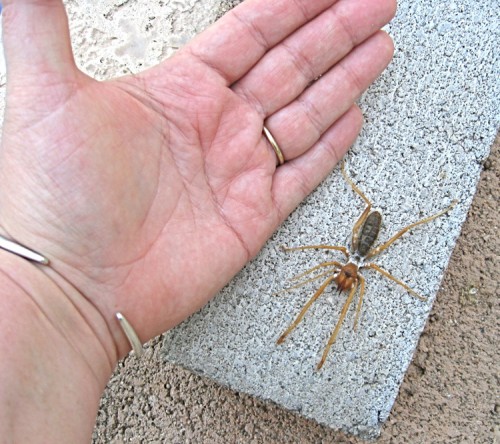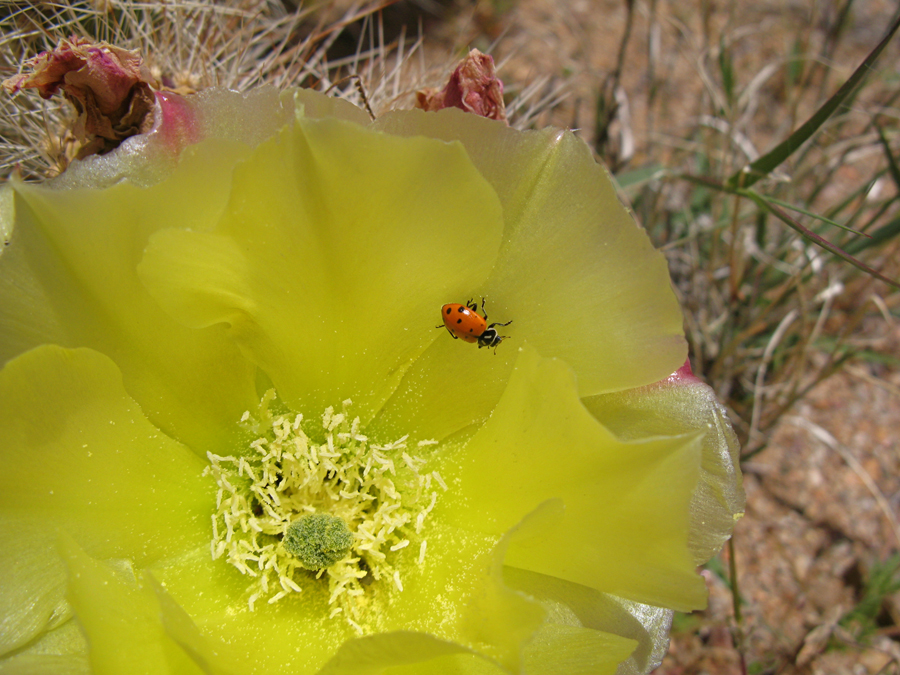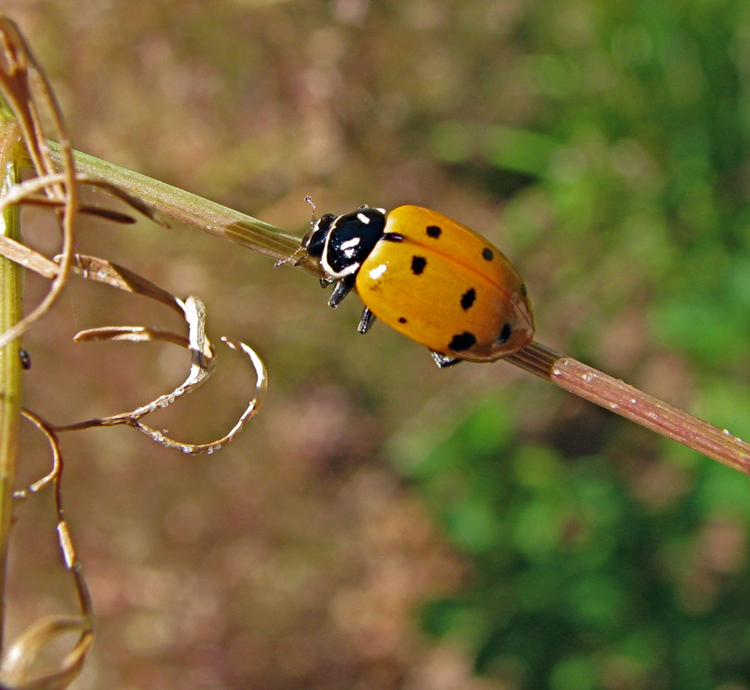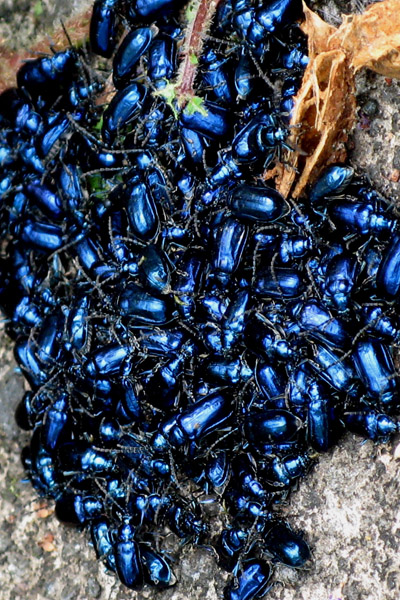The night of the enormous centipede
 Last big monsoon event brought rain and a spadefoot to our Phoenix area yard. Tuesday night’s big monsoon event brought even more rain and a centipede.
Last big monsoon event brought rain and a spadefoot to our Phoenix area yard. Tuesday night’s big monsoon event brought even more rain and a centipede.
This guy is a Scolopendra polymorphus, a Sonoran centipede, sometimes called a tiger centipede. This one is about 4 inches long (they can grow up to about 7 inches), and has crawled up the outside of our back door screen, possibly in search of prey, or maybe to escape flooding in the nearby soil, where it very likely dens up.
It’s a beautiful animal, although I have to admit I’m not partial to centi- or milli-pedes (it may be all the pointy little appendages) but as this one’s a neighbor, I’m trying to be inclusive. Apparently, I’m not the only one who has a hard time liking them. Our cat, Hector Halfsquid, spent the evening on the inside of the wet screendoor alternately approaching hesitantly and hurriedly backing away from the centipede, giving the impression of being simultaneously fascinated and repulsed by it.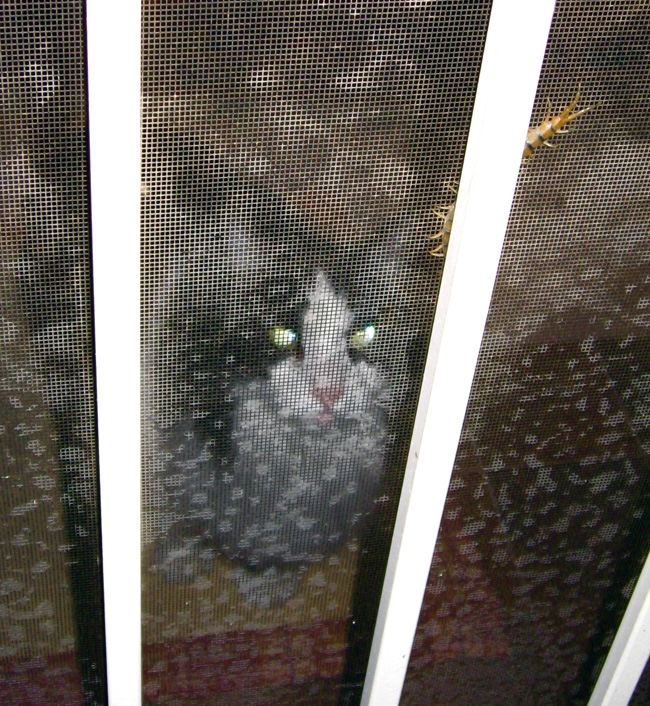
(Photos A.Shock)
In fact, even today he’s still giving occasional neurotic “creepy hops” where from deep sleep he suddenly jumps out of his skin, apparently having received Gary-Larson-esque “cumulative willies” from the many-legged visitor. Hector’s wariness is probably justified, as these guys can deliver a powerful and venomous bite; not dangerous in most cases, but certainly painful.
Whew…
 …back from Sierra Vista and Southwest Wings Festival; tired. Nice show. Thanks to everyone who came by, and thank you to the organizers, who did a good job in a new venue. It’s always nice to see friends, returning customers, and new faces.
…back from Sierra Vista and Southwest Wings Festival; tired. Nice show. Thanks to everyone who came by, and thank you to the organizers, who did a good job in a new venue. It’s always nice to see friends, returning customers, and new faces.
To those of you on my emailing list, if you’re wondering why you didn’t get an advance email notification of the event in your inbox, it’s because I absentmindedly forgot to send out an e-flyer before the show. Hope you found your way to the Three Star Owl booth anyway!
 Right: Coati/scorpion lidded vessel with coati-tail handles (A. Shock, 2010, stoneware, 9.5″ ht)
Right: Coati/scorpion lidded vessel with coati-tail handles (A. Shock, 2010, stoneware, 9.5″ ht)
The lady and the pear
Recent posts have been about lady bugs, and prickly pears. Here’s one about both: a lady bug on an Opuntia blossom in the Mojave desert. (Both photos A.Shock)
You can’t tell, but this particular prickly pear lives in a little piece of Nevada jammed between Arizona and California. Its chief attraction is that it’s also stuffed with Joshua trees, which we’re finding there are more of in the world than we ever thought:
Ladybug heaven was…
…our aphid-infested herb garden.
Last week, we found a lady bug (AKA lady beetle, lady bird beetle) wandering around on the ground; we scooped her up and put her on a cilantro plant badly infested with aphids. A few days later, the flower stalks of the plant were alive with the black-and-orange alligator-like larvae of the ladybug. There were so many 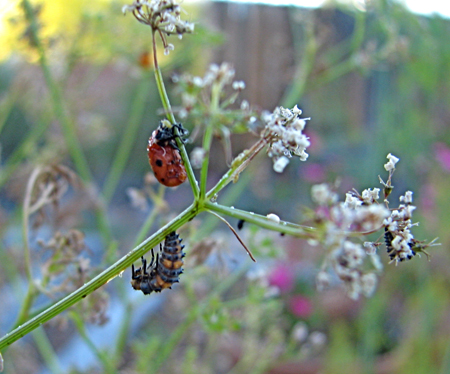 aphids on these stems, the larvae stuck around, pupated, and hatched into mint new beetles. Here’s the process in photos (A & E Shock).
aphids on these stems, the larvae stuck around, pupated, and hatched into mint new beetles. Here’s the process in photos (A & E Shock).
We didn’t think to look for eggs, so the first thing we saw was about two dozen larvae slurping up aphids on the cilantro plant. In the picture on the right >>, the final instar of a larva (lower) is attaching itself to the stem in preparation of pupating. The critter above it, which looks like a wrinkly beetle, is what it becomes: a pupa, waiting for the beetle inside to reach adulthood.
 << The next photo shows a newly-emerged adult beetle clinging to its empty pupal husk. The unripe tomato color of its wings deepens as it dries, possibly in response to UV exposure. Also, ghostly gray dots appear and darken along with the elytra. The wings, pale yellow and transluscent, retract fully under the elytra, and the beetle is ready to trundle — or fly — off.
<< The next photo shows a newly-emerged adult beetle clinging to its empty pupal husk. The unripe tomato color of its wings deepens as it dries, possibly in response to UV exposure. Also, ghostly gray dots appear and darken along with the elytra. The wings, pale yellow and transluscent, retract fully under the elytra, and the beetle is ready to trundle — or fly — off.
The photo below shows two empty pupal cases, the sun shining through them and split open like… well, like invertebrate pupal cases, abandoned where their larvae attached to the stem.
Finally, the familiar mature, deep red-orange, sun-spotted lady bugs 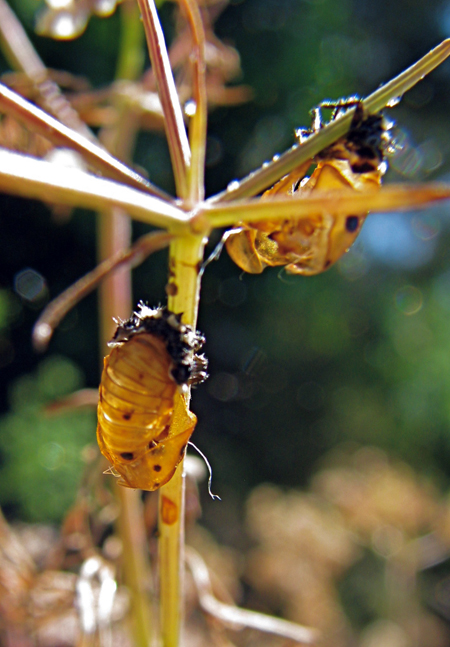 spread out, looking for food and mates to start the cycle all over again (below).
spread out, looking for food and mates to start the cycle all over again (below).
Hard not to appreciate the aphids giving up their sticky little plant-sucking lives for such a delightful result. And, thanks, ladybugs, for clearing out the thuggish aphids. Not to anthropomorphize or anything…
Wild mantid-loaf: imagine another surprise!
A praying mantis egg-case is not something you can easily find if you’re looking for one. So, imagine our surprise — again! — when E looked up at a random, leafy, and low branch of the big backyard mesquite, and said, “Hey,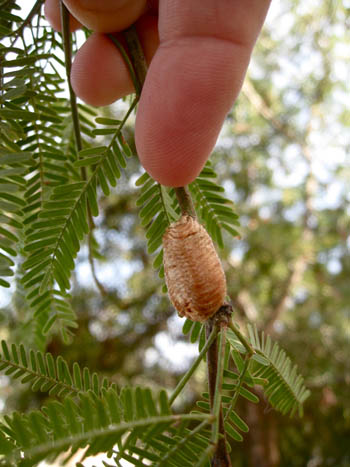 look!” There was a tiny brown-loaf-looking mantid egg case, stuck to a thin twig towards the whippy tip of a branch.
look!” There was a tiny brown-loaf-looking mantid egg case, stuck to a thin twig towards the whippy tip of a branch.
This was our second mantis-related sighting of the week — the other is described here, in the latest post on this blog.
So, we’ll be keeping an eye on this one, to see if it hatches, now that warmer weather is here. And, who knows how many more are out there? With luck, the yard will be mantis-rich before long.
Praying mantis egg-case on mesquite twig, finger for scale (Photo A.Shock) >>
And stay tuned to read about what I encountered under the mesquite just now, while checking on the mantis-egg case…
Lil mantids, or: imagine our surprise
We grow succulents at our house in containers, and some of them can’t take the heat of the low desert summers, while others can’t take the hardest frosts of winter. This results in a constant migration of plants inward and outward between the house and yard, depending on the season. The indoor space the plants inhabit is a set of wall-shelves 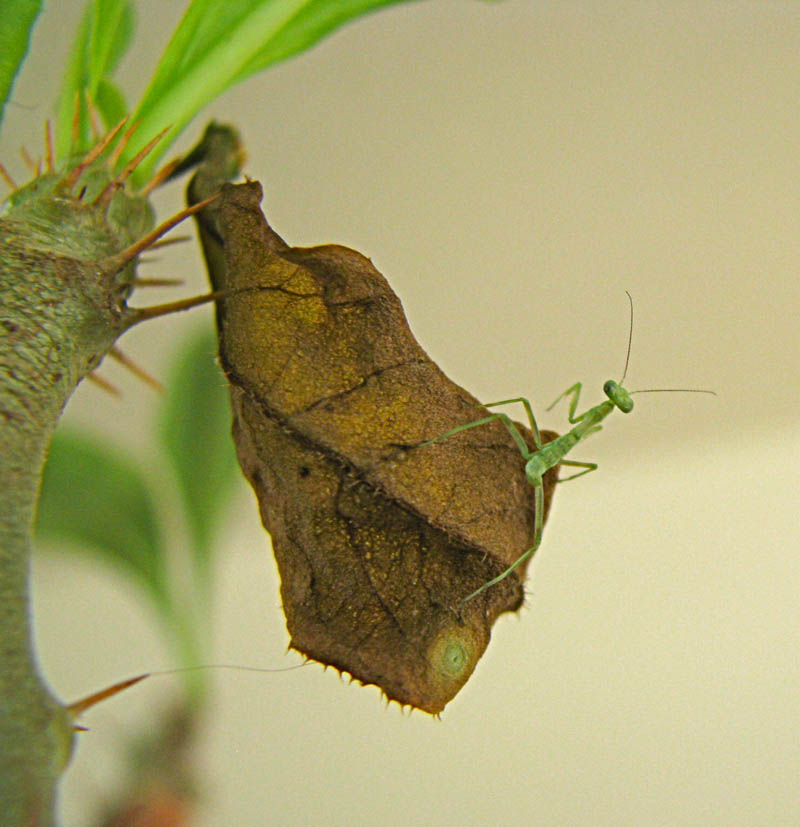 perched in a loft area above the bed. Every once in a while the cats get up there – in the avatar of furry negative forces of destruction and sudden catastrophe – and implement their conviction that one or the other potted plant would be better on the carpet, which results in a loud thump, crushed foliage, and a shower of dirt and gravel onto us in the middle of the night, causing much heart-pounding and swearing.
perched in a loft area above the bed. Every once in a while the cats get up there – in the avatar of furry negative forces of destruction and sudden catastrophe – and implement their conviction that one or the other potted plant would be better on the carpet, which results in a loud thump, crushed foliage, and a shower of dirt and gravel onto us in the middle of the night, causing much heart-pounding and swearing.
The other result of having the indoor-outdoor shift in place is that things get imported into the bedroom that really would be better off outside. Last fall, unbeknownst to us, one of the plants that came in for the cold season was an Adenium where a Praying mantis had secreted her breadloaf-brown egg case. 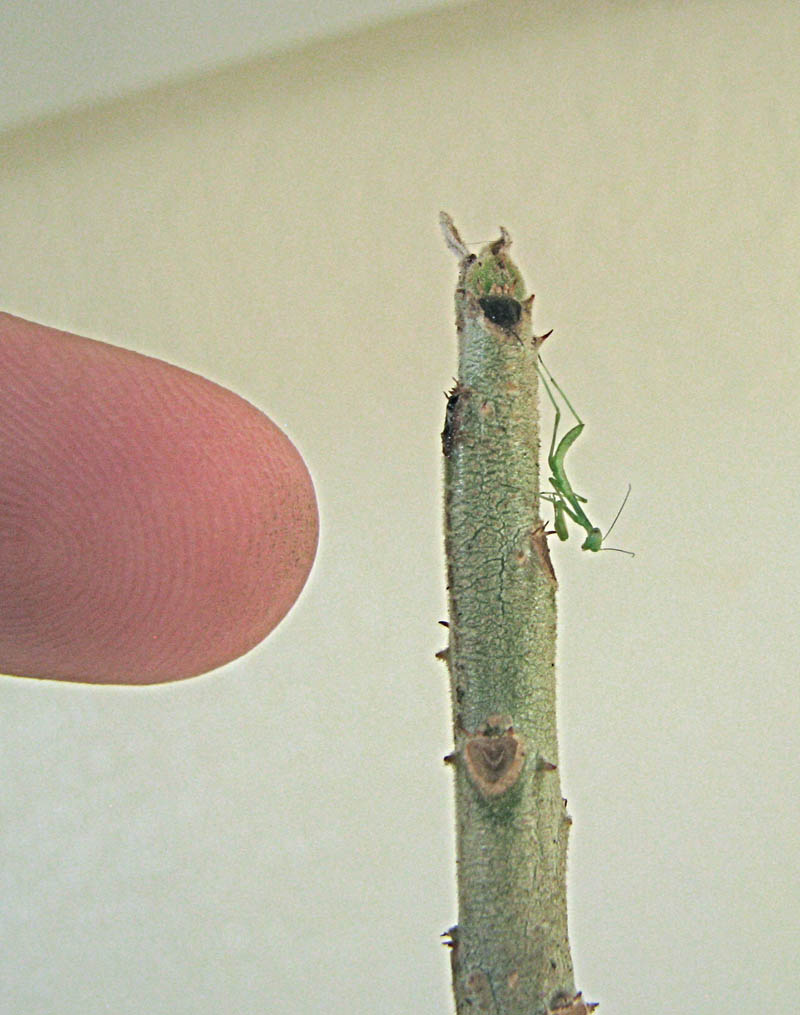 The first we knew about it was when E went up the spiral staircase to water plants, and found, pinnacled on the tip of a succulent, the tiniest possible baby green mantis – looking just like a big one, but not as big as a human fingertip. A quick search around yielded a dozen more, freshly hatched, as well as the egg-case itself on a nearby plant.
The first we knew about it was when E went up the spiral staircase to water plants, and found, pinnacled on the tip of a succulent, the tiniest possible baby green mantis – looking just like a big one, but not as big as a human fingertip. A quick search around yielded a dozen more, freshly hatched, as well as the egg-case itself on a nearby plant.
We instantly whisked the nest-plant outside, before the fur-bearers discovered the movable feast of lively greenlings, and where they could disseminate into the garden and find plenty of food to eat, unlike the largely tiny-prey free desert of the bedroom. We’ve had young mantises around before and they are very voracious younglings, eating anything that moves which they are strong enough to grasp and render immobile. This is the other function of allowing them to wander off, each in a different direction — they will eat each other, if hungry enough.
By next morning, all but one of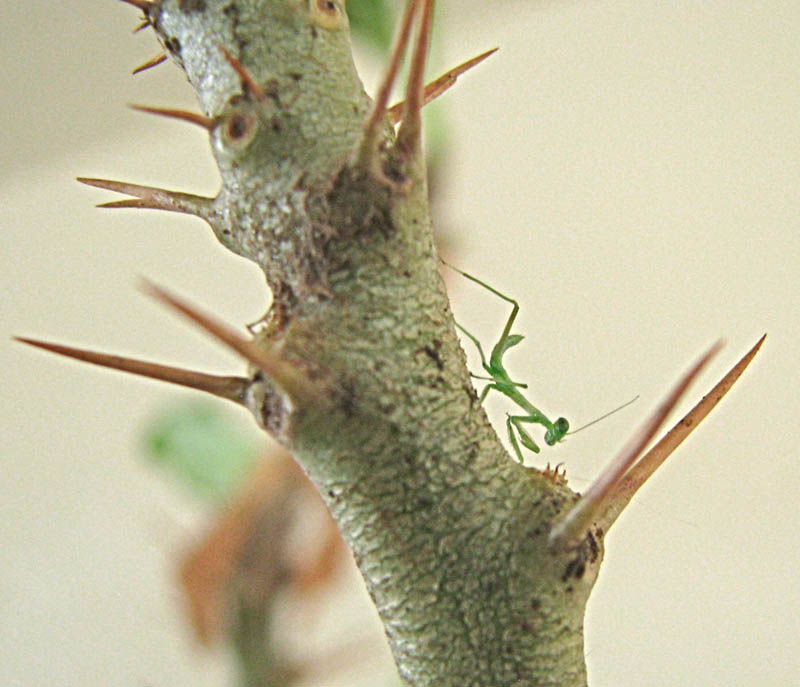 them had made its way away from the eggcase Adenium, except for one guy who figured he was okay where he was. With luck they will mature into one of the mantids native to the Sonoran desert. Or, they may grow into an imported mantid from the Mediterranean or China that people release to control garden pests. Of course, many may be eaten by birds or raccoons, but even that way, they’re in the natural system, and out of the bedroom. Bonne chance, tiny predators!
them had made its way away from the eggcase Adenium, except for one guy who figured he was okay where he was. With luck they will mature into one of the mantids native to the Sonoran desert. Or, they may grow into an imported mantid from the Mediterranean or China that people release to control garden pests. Of course, many may be eaten by birds or raccoons, but even that way, they’re in the natural system, and out of the bedroom. Bonne chance, tiny predators!
(all photos by E. Shock)
Bonus beetles
Here are some boffo blue beetles.
I don’t know anything about them. We found them last year just below a cloud forest in southern Veracruz, Mexico, on the side of a road that crossed a re-grown lava flow.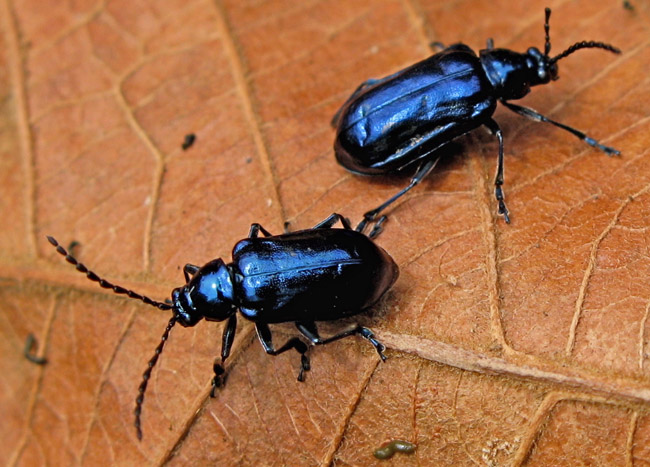 There were hundreds of them, congregating for reasons possible to guess at, but known only to themselves, in an astounding density. Each is just over 1/2 inch long, and the color is true.
There were hundreds of them, congregating for reasons possible to guess at, but known only to themselves, in an astounding density. Each is just over 1/2 inch long, and the color is true.
Here is an bonus unidentified beetle, big and green, seen at the same location. It was almost 2 inches long. The irregular dark shape that looks like backwards Texas in the highlight of its carapace is the reflection of my hand holding the camera. That’s how reflective its shell was. Click to enlarge, and look at all its little pores!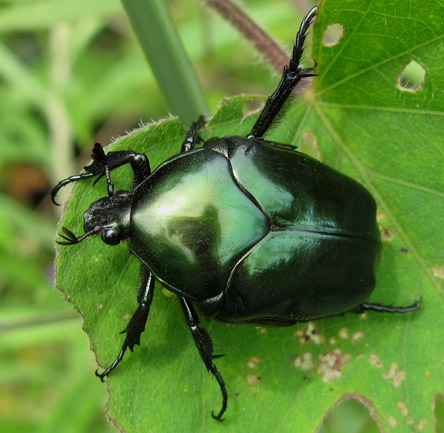
(All photos A.Shock)
Update: After looking around the internet, I believe the green beetle on the left is a Fig beetle, Cotinus sp.
I’m also working on the theory that the blue beetles may be cobalt milkweed beetles, Chrysochus cobaltinus, but further investigation is needed.
If these IDs are correct, both beetles are quite common, and also occur in the southern US. The fig beetle is a favorite prey item of Mississippi kites, and no wonder — it looks like it might have some meat under its hood.
Late Night Arthropod: Vaejovis aglow
Scorpions are not a thing at our house. We don’t see them frequently, and as previously posted, they’re more likely to be encountered outside as victims of the swimming pool than inside the house. But last night E liberated one from the front bathroom, and temporarily incarcerated it in a pint glass.
In the morning, I wanted to watch it glow. Here’s a picture of it viewed under a UV light, with the glass’s Duralex logo for scale. It’s another “striper”: Vaejovis spinigera, a stripe-tailed scorpion, our most common species.
There are places in the Greater Phoenix famous for their scorpionicity. So much so, that you can find maps of the frequency of scorpion stings on the internet, for the benefit of people new to the area who might want the info while searching for a house to buy. (We looked at a map of Superfund sites, but everyone has to prioritize their own worries). Such a map is to the right: the darkest areas show the areas with the most stings reported, so it’s more likely to reflect factors such as human population density or likeliness of going to the hospital than actual scorpion presence. Also, the map doesn’t indicate actual numbers or a unit of time, so there’s no knowing if the darkest red are so many stings a year, or so many stings a minute. But, it provides a rough idea of who should invest in a hand-held black-light, and who’s most likely to subscribe to weekly pest control.
(We looked at a map of Superfund sites, but everyone has to prioritize their own worries). Such a map is to the right: the darkest areas show the areas with the most stings reported, so it’s more likely to reflect factors such as human population density or likeliness of going to the hospital than actual scorpion presence. Also, the map doesn’t indicate actual numbers or a unit of time, so there’s no knowing if the darkest red are so many stings a year, or so many stings a minute. But, it provides a rough idea of who should invest in a hand-held black-light, and who’s most likely to subscribe to weekly pest control.
Oddly, the scorpion-rich areas are not all desert neighborhoods as you might expect: there’s a hot spot in Tempe with lawns and sprinklers and rose-bushes, and another in the central corridor of older Phoenix. We’ve got friends who live there, and they see scorps way more often than we do, and have been stung. As a kid in Phoenix, I remember being afraid of scorpions after hearing stories of people leaving wet washcloths on the bathroom floor, and finding several of them clinging to the underside of it when it was picked up next morning. (Scorpions love getting under things and hanging there upside down. Biologists call this “reverse geotaxis”: the habit of aligning yourself in reverse to the surface of the earth.) Fortunately, in our area, for most people the sting of most scorpions is a painful inconvenience, and nothing more. There are places in the world where there are much more potent scorps, and their sting is a medical matter and is even occasionally fatal.
After its photo-session, I released this striper in the back yard, under a Cenizo bush, where it clung to some foliage. By the time the sun strikes the plant, it’ll be back in a hidey-hole until night falls again.
(Photo A.Shock; scorpion wrangling E.Shock)


